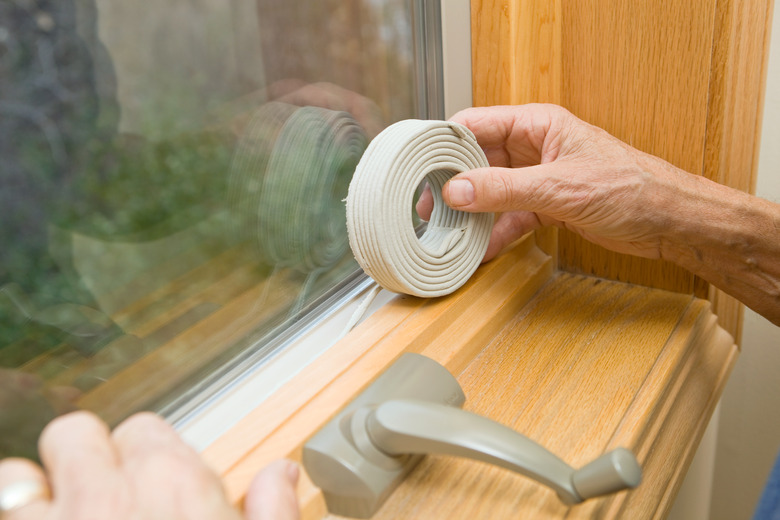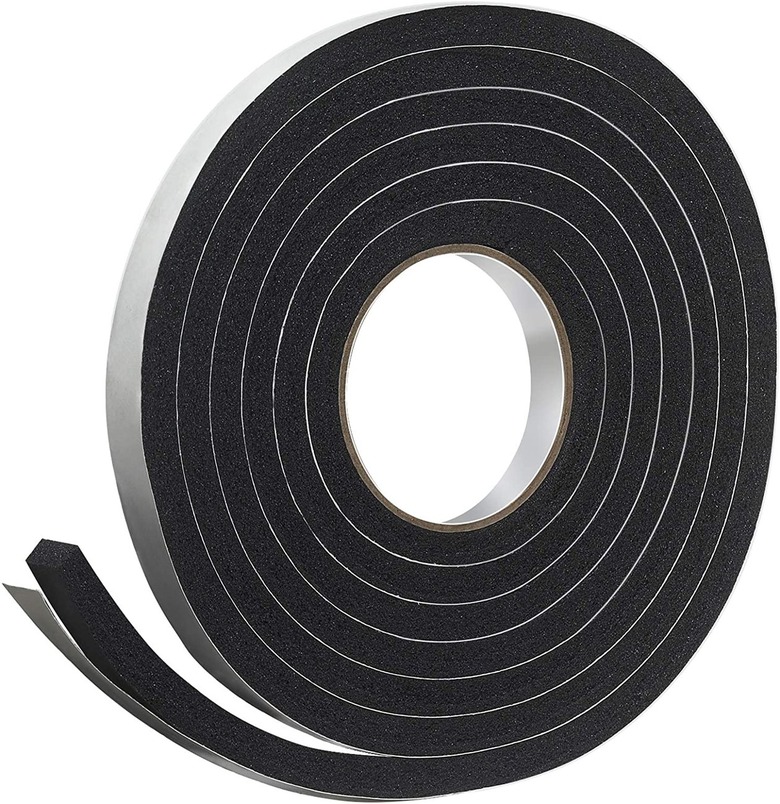A Beginner's Guide To Choosing And Installing Weatherstripping
We may receive a commission on purchases made from links.
There are many strategies to help make a home energy efficient, but one of the most straightforward ways involves applying weatherstripping around drafty doors and windows. Eliminating cold air drafts makes the area around the windows and doors more comfortable, and you can reduce your heating and cooling bill.
Weatherstripping is just one component that goes into making a house more energy efficient, but from a DIY standpoint, it is the low-hanging fruit of projects. While some projects that save energy involve adding insulation, sealing holes and gaps in the dusty attic or crawling around in tight spaces to seal heating and cooling ducts, applying weatherstripping to doors and windows is a simple and relatively inexpensive chore.
You can make just about any type of window or door more energy efficient with the right type of weatherstrip, and you can do it using the tools you probably already have on hand. Some types of weatherstripping don't require the use of any tools at all except maybe scissors to cut it to length.
Why Weatherstripping Works
Why Weatherstripping Works
Weatherstripping is one piece of the energy-efficiency puzzle, and it does the most good during the winter heating season. As the heating system warms the house, the air rises and tries to find its way out of the house through cracks and other openings near the top of the building. As it exits the building, the change in pressure pulls outside air into the house through openings around doors and windows as well as in other places. The process is called the stack, or chimney, effect.
You can slow down the stack effect by sealing the openings near the top of the house, such as cracks in the ceiling and pipe and wire penetrations that go through the attic floor. Most recessed light fixtures also allow heated air to escape. Weatherstripping doors and windows is part of an energy strategy because it complements other air-sealing tasks by keeping outside air from getting in.
Of course, the wind itself can be the source of window and door drafts. Weatherstripping works during the summer as well by blocking hot outside air from getting inside and making the air conditioner work harder.
Detecting Air Leaks
Detecting Air Leaks
If you can feel a draft or see light from outside, the window or door needs your attention. In some cases, you may need to caulk around the frame of the window or door. A good rule of thumb is if the crack is on a part of the window or door that does not move, caulk it. If it moves, use weatherstripping to stop the draft.
An outside energy auditor can help you detect subtle leaks. The auditor may use a blower door test on your home or place a large fan in an exterior door. The fan lowers the air pressure in the house, causing outside air to be drawn in through small openings. They will then use a smoke pencil to determine where the leaks are located.
Although it's helpful to have a professional assist with this task, you can easily search for small leaks yourself by looking around windows and doors with an incense stick or a smoke pencil. Do a search around all of the openings in your home — even around newer energy-efficient windows. They probably have adequate weatherstripping, but the material does wear out, and if the windows were installed incorrectly, they probably allow for at least a little air infiltration.
Types of Weatherstripping
Types of Weatherstripping
If you head to the weatherstripping aisle at your local home improvement center or hardware store, you are going to find a lot of different products. Some are made of metal and others of vinyl, foam, rubber or felt. Most types have an adhesive applied to one side for easy installation, but there are types that require nail-on installation.
Most V-shaped spring strips are made of vinyl, although those made of bronze or aluminum and foam rubber V-strips in a plastic covering are also available. When installed, one side of the V springs away from the other. When the door or window is closed, the V compresses, forming a tight seal.
Foam weatherstrip comes in rolls of different thicknesses. They have self-adhesive backing and are usually installed against the stops of doors and windows. When the unit closes, it compresses the foam.
Rolled vinyl and rubber gaskets look like hollow tubes when you cut them. The gasket part is attached to a narrow flange. Most are self-adhering and work on the same principle as the foam tapes.
Felt strips are another low-cost option. They are not very attractive when visible, and they tend to wear out in a few years.
Removable sealants take a novel approach to weatherstripping. They look like and are applied like caulk, but unlike caulks that are formulated to last for years, removable sealants are designed to peel away easily when they are not needed. You can seal a window frame in the fall and then remove the sealant in the spring. Stuff foam backer rod into gaps larger than 1/4 inch before applying the sealant.
Door sweeps are designed to block drafts from coming in under doors. Most are simply screwed to the bottom of the door. There are also special weatherstripping thresholds for doors.
Garage door weatherstripping consists of two different types. One is a bottom-of-the-door rubber gasket. The other is vinyl strips that are attached to the sides and top of the door. This type of weatherstripping is installed on the outside of the door.
How to Install Weatherstripping on Single- or Double-Hung Windows
How to Install Weatherstripping on Single- or Double-Hung Windows
Although there are many types of weatherstripping appropriate for windows, V-strips are a good choice for single-hung and double-hung windows where the window sash slides up and down in a channel. The constant movement can wear out or dislodge other types of insulation.
To apply weatherstripping to any window, make sure the channels are clean and free of loose paint. If there is already some weatherstripping in place, remove it and clean the area.
- Open either the top or bottom sash for a double-hung window.
- Measure the side channels and cut the V-strip to length. If the material comes flat, create the V by creasing the tape down the middle.
- Remove the protective backing and press the adhesive side of the strip against the walls of the window channel with the open side of the V facing outward.
- Attach the material to the top of the top rail of the top sash and the bottom of the bottom rail of the bottom sash. Where the two sashes meet, install a section of V-strip on the inside face of the bottom rail of the top sash with the open side facing down.
- Lock the window to draw the top and bottom sash close together.
Weatherstripping Other Types of Windows
Weatherstripping Other Types of Windows
For casement windows, install foam tape or gasket-type weatherstripping along the sides and top and bottom of the window beside the stops. Make sure the areas are clean. Cut the material to length and press it in place. Test the window to make sure the weatherstripping allows it to close properly.
You can use the same technique on the sides of awning windows — the type that open out with a hinge at the top of the frame. You can also attach V-strips to the top and bottom frames.
When it comes sliding windows, think of them as double-hung windows turned on their side. Install V-strips in the channels in which the windows travel.
Some newer windows have weatherstripping built into the frame, and you may need a manufacturer-approved product to replace it. As long as it does not interfere with the operation of the window, you can supplement integral weatherstripping with material that you apply.
How to Install Weatherstripping on Entry Doors
How to Install Weatherstripping on Entry Doors
You can stop drafts along the sides and top of entry doors by installing foam tape or a rubber gasket-style weatherstripping. Installing these self-adhesive materials only involves just a couple of steps.
- Cut the foam tape or rubber-gasket style weatherstripping to size for the door stops on the sides and top of the door.
- Remove the protective backing and press the adhesive against the door stops and the top of the door.
- Test the door to make sure it closes and locks easily.
There is also a type of weatherstripping that is installed in a groove that is cut into the door frame. It is an effective way to eliminate drafts, but cutting the groove is best left to a professional.
Install a Door Sweep
Install a Door Sweep
The biggest source of drafts around a door is most likely the space between the door bottom and the floor, or the door threshold. Block this area by installing a door sweep. Some sweeps are U-shaped and fit over the bottom of the door, which means you have to remove the door's hinges and lay the door flat for installation.
There is a type that you attach to the interior face of the door a few inches up from the bottom. There are different styles available, but the brush type works well on both hard-surface flooring and carpeting. You may have to adjust the sweep a few times to ensure that you seal the gap while allowing the door to open and close easily.
How to Install Weatherstripping on Garage Doors
How to Install Weatherstripping on Garage Doors
Homeowners often forget about the doors on attached garages when it comes to saving energy, but the perimeter of the door can be a pathway for a large amount of outside air. There are two types of weatherstripping that you'll need to use on garage doors.
- Tack vinyl strips made for garage doors to the outside of the door frame. (The material has a lip that covers the opening between the frame and the door.)
- Install the material on the sides of the door and at the top.
- For a neat appearance and an effective seal, cut miter ends where the top and side pieces meet.
The bottom of garage doors contains an integral vinyl or rubber weatherstripping that sits in a holder. The material can wear out, and when it does, it needs to be replaced. On some doors, you have to replace the holder and the weatherstripping in one piece. On others, you can remove the weatherstripping and replace it with a new piece. Consult the door manufacturer to determine which type you have.
Other Weatherstripping Opportunities
Other Weatherstripping Opportunities
Weatherstripping is the gift that keeps on giving when it comes to energy savings. Some other opportunities for using weatherstripping include the door that connects the living space with an attached garage, which is often overlooked. Apply weatherstripping to it like you would any other door, even if you weatherstripped the garage door.
Attic doors and hatches should also be weatherstripped. For a pull-down attic hatch, apply felt or foam tape to the hatch's stops. If it isn't already insulated, apply insulation to the attic side of the hatch, especially on pull-down hatches where the rest of the attic floor is insulated.
Window air conditioners also require attention. There are foam strips that are 1 1/4 to 1 1/2 inches thick and are designed to fill the open spaces around a window unit. Just wedge it in place on the sides and over the top of the air conditioner. A separate piece can be used to fill the gap between the upper and lower sash.
Sealing electrical outlets and light switches can also help prevent energy loss. There are thin foam inserts available that you install behind the faceplate of the switch or outlet. They have cutouts for the switch or receptacle, and you can find products to accommodate single and double switches or receptacles.
Sealing outlets and switches helps prevent air infiltration on outside walls. They also cut off an escape route of warm air that is looking for a way out of the house due to the stack effect.


